Der Beitrag der integrativen Gestaltpädagogik nach Albert Höfer im Bereich der holistischen Religionspädagogik
DOI:
https://doi.org/10.15633/pch.3370Słowa kluczowe:
Gestalt, integrative gestalt pedagogy, Albert Höfer, holistic-personal learning process, personal development and religious dimension of a learnerAbstrakt
Integrative Gestalt pedagogy is a comprehensive pedagogy that based on Gestalt theory (-philosophy, -psychology, -therapy, -pedagogy), humanistic psychology and pedagogy. In the 1980s its holistic approach was used by Dr Albert Höfer to reform the concept of the Austrian religious education. Höfer succeeded in designing a complete Gestalt-pedagogical model of learning and teaching, whose uniqueness can be seen in its approaches that encourage student’s personal growth. In accordance with Jesus’s teaching it looks at students in a loving and caring way, talking to them in their everyday situations and opening them to religious experience and God’s working in their lives. This has been confirmed by empirical research.
Bibliografia
Burow O. A., Gudjons H., Gestaltpädagogik in der Schule, Hamburg 1998, Bergmann+Helbig Verlag.
Centa M., Kognitivna teorija čustev, vrednostne sodbe in moralnost, „Bogoslovni vestnik“ 78 (2018) 1, S. 53-65.
Feiner F., Albert Höfers katechetische Impulse durch seine Schüler- und Lehrerhandbücher und die Fortführung seines Werkes in VS, HS, AHS-Unterstufe und ASO, in: H. Neuhold, Leben fördern – Beziehung stiften. Festschrift für Albert Höfer, Graz 1997, Institut für Integrative Gestaltpädagogik und Seelsorge, S. 56–77.
Gerjolj S., Geštaltpedagogika kot celostna pedagogika, in: „Vseživljenjsko učenje in strokovno izrazje“, Ljubljana 2008, Pedagoški inštitut, S. 139-148.
Höfer A. und Höfler A., Das Glauben lernen: Schwerpunkte der Religionspädagogik, Donauwörth 1974, Verlag Ludwig Auer.
Höfer A. und J. Thiele. Spuren der Ganzheit: Impulse für eine ganzheitliche Religionspädagogik, München 1982, Verlag J. Pfeiffer.
Höfer A., Lachmayer E., Glettler M., Reischl W. und Ules E., Gestalt des Glaubens: Beispiele aus der Praxis gestaltorientierter Katechese, München 1982, Verlag J. Pfeiffer.
Höfer A., Feiner F., Perstling J. und Schrettle A., Die neuen Glaubensbücher: Einführung in die integrative Religionspädagogik 5. – 8. Schulstufe, Graz 1979, Verlag Styria.
Höfer A., Gestaltpädagogik von und nach Albert Höfer. „Zeitschrift für Integrative Gestaltpädagogik und Seelsorge“ 39 (2005), S. 7-9.
Höfer A., Gottes Wege mit den Menschen: ein gestaltpädagogisches Bibelwerkbuch, München 1997, Don Bosco Verlag.
Höfer A., Pädagogik, in: Höfer A. und Steiner K., Handbuch der Integrativen Gestaltpädagogik und Seelsorge, Beratung und Supervision: Unser Menschenbild, Graz 2004, LogoMedia-Verlag Graz, S. 8-15.
Klaushofer J. W., Gestalt, Ganzheit und heilsame Begegnung im Religionsunterricht: Eine Auseinandersetzung mit der Gestaltkatechese von Albert Höfer, Salzburg 1989, Otto Müller Verlag.
Maier G., Christian von Ehrenfels und seine Entdeckung der „Gestalt“: Anwendung in der Gestaltpädagogik, -seelsorge und -therapie. „Zeitschrift für Integrative Gestaltpädagogik und Seelsorge“ 38 (2005) 2, S. 5-9.
Neuhold H., Integrative Gestaltpädagogik und heilende Seelsorge als reformpädagogische Bewegung, „Zeitschrift für Integrative Gestaltpädagogik und Seelsorge“ 43 (2006), S. 10-13.
Nežič Glavica I., Izkustveno učenje in poučevanje po Albert Höferju, doktorska disertacija, Teološka fakulteta Univerze v Ljubljani 2017.
Reichel R. und Scala E., Das ist Gestaltpädagogik: Grundlagen, Impulse, Methoden, Praxisfelder, Ausbildungen, Münster 2005, Ökotopia Verlag.
Stala J., Die Transzendenz als bestimmendes Merkmal der Person in der Anthropologie und der Pädagogik Johannes Pauls II., “The Person and the Challenges“ 2 (2012) 1, S. 61-75.
Stein R., Einführung in die pädagogische Gestaltarbeit und die gestalttheoretische Sicht von Störungen, Stuttgart 2005, Schneider Verlag Hohengehren.
Vodičar J., Religiosität als erwünschte Anregung in der Hermeneutik, „The Person and the Challenges“ 1 (2011) 1, S. 127-150.
Vodičar J., Narativna kateheza, „Bogoslovni vestnik“ 70 (2010) 4, S. 553-563.
Pobrania
Opublikowane
Numer
Dział
Licencja
Prawa autorskie (c) 2019 Iva Nežič Glavica

Utwór dostępny jest na licencji Creative Commons Uznanie autorstwa 4.0 Międzynarodowe.
Autorzy publikujący w czasopiśmie udzielają jego wydawcy zgody o następującej treści:
- Autor zachowuje autorskie prawa majątkowe do utworu, a jednocześnie udziela wydawcy czasopisma zgody na jego pierwszą publikację w wersji drukowanej i wersji online na licencji Creative Commons Uznanie autorstwa 4.0 Międzynarodowe oraz zgody na wykonywanie opracowań, w tym przekładów.
- Autor ma możliwość udzielania zgody niewyłącznej na opublikowanie utworu w wersji, która ukazała się w czasopiśmie (np. zamieszczenia go w repozytorium instytucjonalnym lub opublikowania w książce), wraz z informacją o jego pierwszej publikacji w czasopiśmie.
- Autor może umieścić swój utwór online (np. w repozytorium instytucjonalnym lub na swojej stronie internetowej) jeszcze przed zgłoszeniem utworu do czasopisma.

